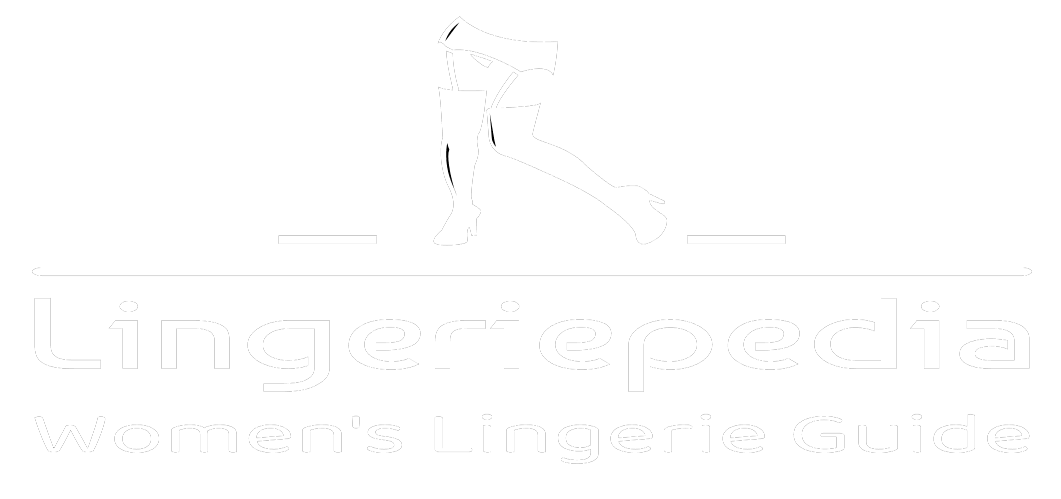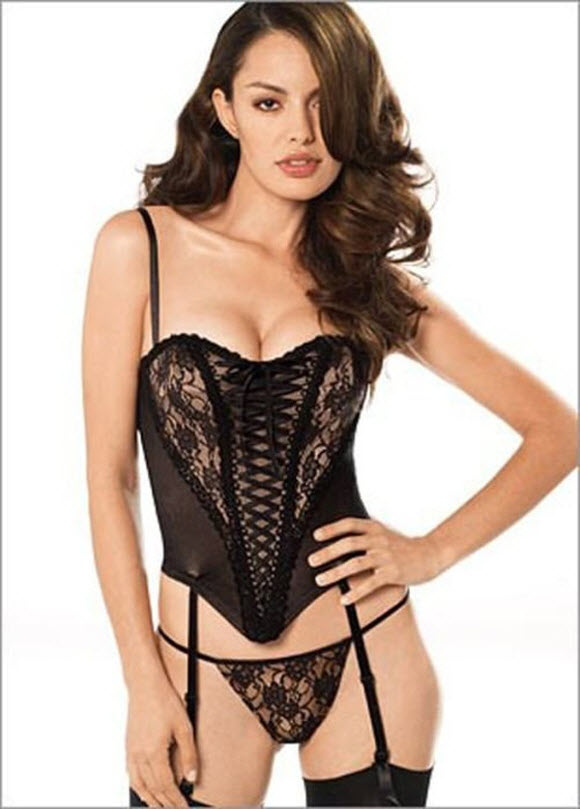A corset is a garment worn to hold and shape the torso into a desired shape for aesthetic or medical purposes (either for the duration of wearing this item, or with a more lasting effect).
Both men and women are known to wear corsets, though women are more common wearers.
In recent years, the term “corset” has also been borrowed by the fashion industry to refer to tops which, to varying degrees, mimic the look of traditional corsets without actually acting as one. While these modern corsets and corset tops often feature lacing or boning and generally mimic a historical style of corsets, they have very little if any effect on the shape of the wearer’s body. Genuine corsets are usually made by a corsetmaker and should be fitted to the individual wearer.
Etymology
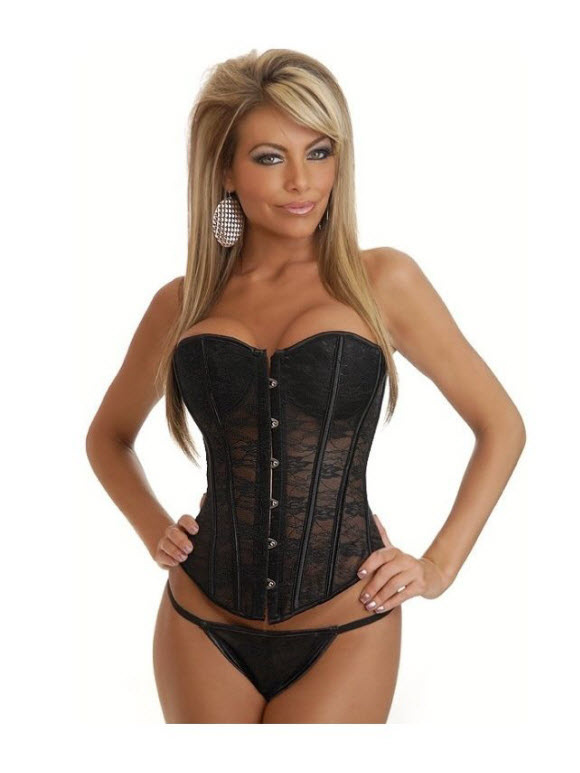
The word corset is derived from the Old French word corps and the diminutive of body, which itself derives from corpus—Latin for body. The craft of corset construction is known as corsetry, as is the general wearing of them. (The word corsetry is sometimes also used as a collective plural form of corset.) Someone who makes corsets is a corsetier or corsetière (French terms for a man and for a woman, respectively), or sometimes simply a corsetmaker.
The word corset came into general use in the English language in 1785. The word was used in The Ladies Magazine to describe a “quilted waistcoat” called un corset by the French. The word was used to differentiate the lighter corset from the heavier stays of the period.
Uses
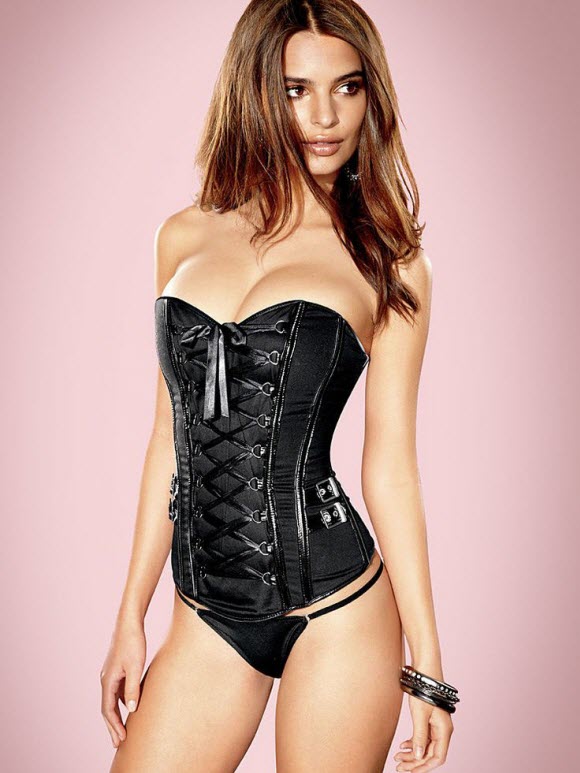
Fashion
The most common and well-known use of corsets is to slim the body and make it conform to a fashionable silhouette. For women this most frequently emphasizes a curvy figure, by reducing the waist, and thereby exaggerating the bust and hips. However, in some periods, corsets have been worn to achieve a tubular straight-up-and-down shape, which involves minimizing the bust and hips.
For men, corsets are more customarily used to slim the figure. However, there was a period from around 1820 to 1835 when a wasp-waisted figure (a small, nipped-in look to the waist) was also desirable for men; this was sometimes achieved by wearing a corset.
An overbust corset encloses the torso, extending from just under the arms to the hips. An underbust corset begins just under the breasts and extends down to the hips. Some corsets extend over the hips and, in very rare instances, reach the knees. A shorter kind of corset, which covers the waist area (from low on the ribs to just above the hips), is called a waist cincher. A corset may also include garters to hold up stockings (alternatively a separate garter belt may be worn for that).
Normally a corset supports the visible dress, and spreads the pressure from large dresses, such as the crinoline and bustle. Sometimes a corset cover is used to protect outer clothes from the corset and to smooth the lines of the corset. The original corset cover was worn under the corset to provide a layer between it and the body. Corsets were not worn next to the skin, possibly due to difficulties with laundering these items during the 19th century, as they had steel boning and metal eyelets which would rust. The corset cover would be in the form of a light chemise, made from cotton lawn or silk.
Medical
People with spinal problems such as scoliosis or with internal injuries may be fitted with a form of corset in order to immobilize and protect the torso. Andy Warhol was shot in 1968 and never fully recovered, and wore a corset for the rest of his life.
Fetish
Aside from fashion and medical uses, corsets are also used in sexual fetishism, most notably in BDSM activities. In BDSM, a submissive can be forced to wear a corset which would be laced very tight and give some degree of restriction to the wearer. A dominant can also wear a corset, often black, but for entirely different reasons, such as aesthetics, and to achieve a severe, armored, “unbending”, commanding appearance. A very common fetish costume for women is the dominatrix costume. Usually it consists of mostly dark or even black clothing. The woman usually wears a corset or bustier and stockings with high-heeled footwear. High boots are quite common as they enhance the woman’s domination. Women in dominatrix costumes usually carry an accessory such as a whip or a riding crop. A specially designed corset, in which the breasts and vulva are left exposed can be worn during vanilla sex or BDSM activities.
Construction
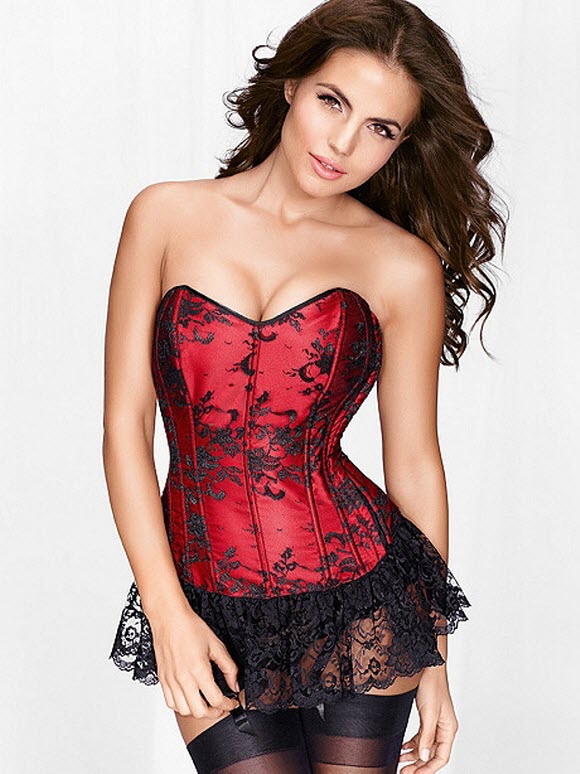 Corsets are typically constructed of a flexible material (like cloth, particularly coutil, or leather) stiffened with boning (also called ribs or stays) inserted into channels in the cloth or leather. In the 19th century, bones of whale were favoured for the boning. Plastic is now the most commonly used material for lightweight corsets and the majority of poor quality corsets, whereas spring or spiral steel is preferred for stronger corsets and generally the better quality corset too. Other materials used for boning include ivory, wood, and cane. (By contrast, a girdle is usually made of elasticized fabric, without boning.)
Corsets are typically constructed of a flexible material (like cloth, particularly coutil, or leather) stiffened with boning (also called ribs or stays) inserted into channels in the cloth or leather. In the 19th century, bones of whale were favoured for the boning. Plastic is now the most commonly used material for lightweight corsets and the majority of poor quality corsets, whereas spring or spiral steel is preferred for stronger corsets and generally the better quality corset too. Other materials used for boning include ivory, wood, and cane. (By contrast, a girdle is usually made of elasticized fabric, without boning.)
Corsets are held together by lacing, usually (though not always) at the back. Tightening or loosening the lacing produces corresponding changes in the firmness of the corset. Depending on the desired effect and time period, corsets can be laced from the top down, from the bottom up, or both up from the bottom and down from the top, using two laces that meet in the middle. It is difficult—although not impossible—for a back-laced corset-wearer to do his or her own lacing. In the Victorian heyday of corsets, a well-to-do woman’s corset laces would be tightened by her maid, and a gentleman’s by his valet. However, Victorian corsets also had a buttoned or hooked front opening called a busk. If the corset was worn loosely, it was possible to leave the lacing as adjusted and take the corset on and off using the front opening (if the corset is worn snugly, this method will damage the busk if the lacing is not significantly loosened beforehand). Self-lacing is also almost impossible with tightlacing, which strives for the utmost possible reduction of the waist. Corset and bodice lacing became a mark of class, front laced bodices being worn by women who could not afford servants.
Waist reduction
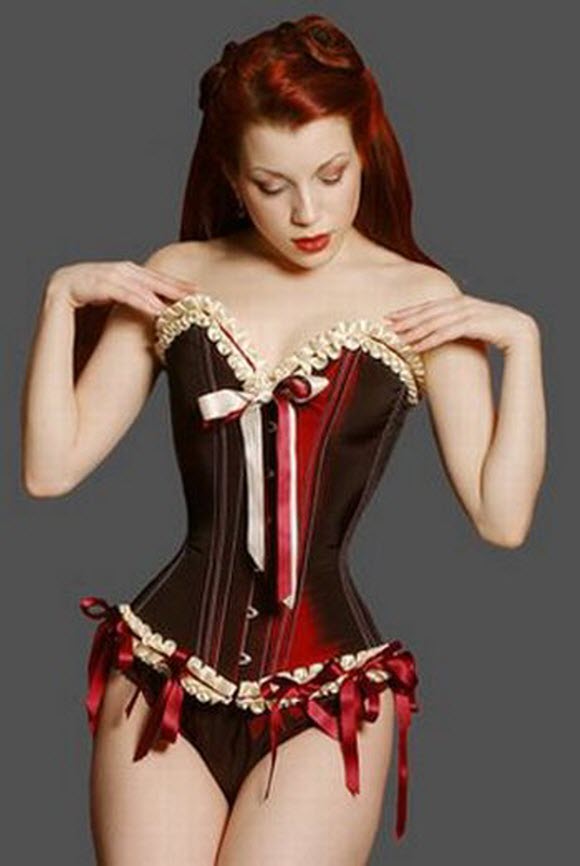
By wearing a tightly-laced corset for extended periods, known as tightlacing, men and women can learn to tolerate extreme waist constriction and eventually reduce their natural waist size. Many tightlacers dream of waists that are 16 inches (41 cm) and 17 inches (43 cm), but are usually satisfied with anything under 20 inches (51 cm). Some went so far that they could only breathe with the top part of their lungs. This caused the bottom part of their lungs to fill with mucus. Symptoms of this include a slight but persistent cough, as well as heavy breathing, causing a heaving appearance of the bosom. Until 1998, the Guinness Book of World Records listed Ethel Granger as having the smallest waist on record at 13 inches (33 cm). After 1998, the category changed to “smallest waist on a living person” and Cathie Jung took the title with a waist measuring 15 inches (38 cm). Other women, such as Polaire, also have achieved such reductions (14 inches (36 cm) in her case).
However, these are extreme cases. Corsets were and are still usually designed for support, with freedom of body movement, an important consideration in their design. Present day corset-wearers usually tighten the corset just enough to reduce their waists by 2 inches (5.1 cm) to 4 inches (10 cm); it is very difficult for a slender woman to achieve as much as 6 inches (15 cm), although larger women can do so more easily.
Corset comfort
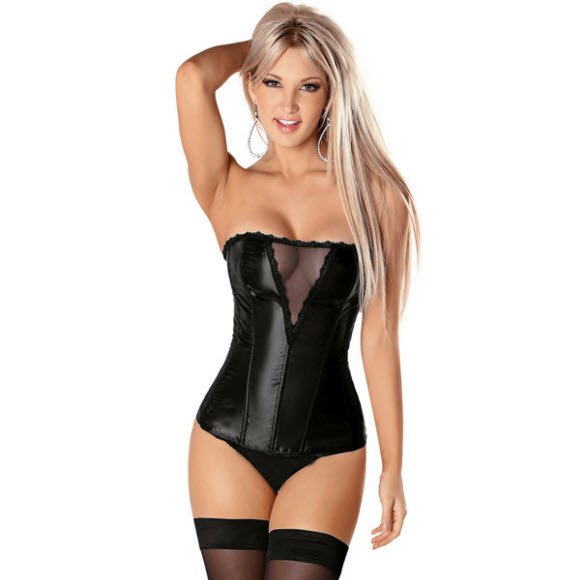
In the past, a woman’s corset was usually worn over a chemise, a sleeveless low-necked gown made of washable material (usually cotton or linen). It absorbed perspiration and kept the corset and the gown clean. In modern times, an undershirt or corset liner may be worn.
Moderate lacing is not incompatible with vigorous activity. Indeed, during the second half of the 19th century, when corset wearing was common, there were sport corsets specifically designed to wear while bicycling, playing tennis, or horseback riding, as well as for maternity wear.
History
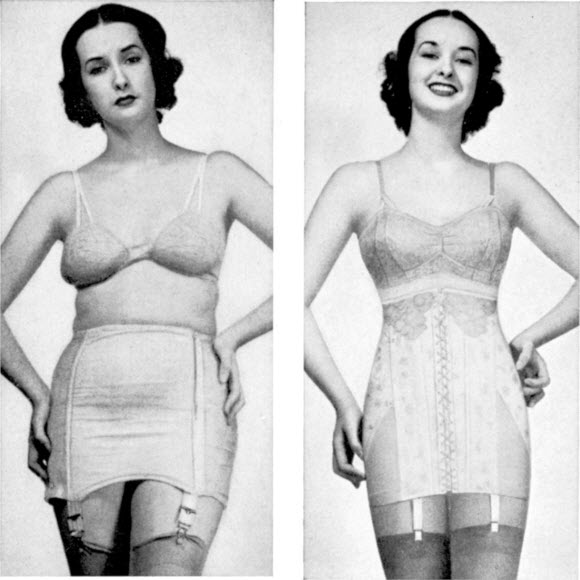
The corset has been erroneously attributed to Catherine de’ Medici, wife of King Henry II of France. She enforced a ban on thick waists at court attendance during the 1550s. For nearly 350 years, women’s primary means of support was the corset, with laces and stays made of whalebone or metal. Other researchers have found evidence of the use of corsets in early Crete.
The corset has undergone many changes. The corset was originally known as stays in the early 16th century. It was a simple bodice with tabs at the waist, stiffened by horn, buckram, and whalebone. The center front was further reinforced by a busk made of ivory, wood, or metal. It was most often laced from the back, and was, at first, a garment reserved for the aristocracy.
Stays took a different form in the 18th century, whalebone began to be used more, and there was more boning used in the garment. The shape of the stays changed as well. The stays were low and wide in the front, while in the back they could reach as high as the upper shoulder. Stays could be strapless or use shoulder straps. The straps of the stays were attached in the back and tied at the front sides.
The purpose of 18th century stays was to support the bust, confer the fashionable conical shape while drawing the shoulders back. At this time, the eyelets were reinforced with stitches, and were not placed across from one another, but staggered. This allowed the stays to be spiral laced. One end of the stay lace is inserted and knotted in the bottom eyelet, the other end is wound through the stays’ eyelets and tightened on the top. Tight-lacing was not common in this time period, and indulged in only by the very fashionable. Stays were worn by women in all societal levels, from ladies of the court to street vendors.
At this time, there were two other variants of stays, jumps, which were looser stays with attached sleeves, like a jacket, and corsets.
Corsets were originally quilted waistcoats, worn by French women as an alternative to stiff corsets.They were only quilted linen, laced in the front, and un-boned. This garment was meant to be worn on informal occasions, while stays were worn for court dress. In the 1790s, stays fell out of fashion. This development coincided with the French Revolution, and the adoption of neoclassical styles of dress. Interestingly, it was the men, Dandies, who began to wear corsets. The fashion persisted thorough the 1840s, though after 1850 men who wore corsets claimed they needed them for “back pain”.
Stays went away in the late 18th century, but the corset remained. Corsets in the early 19th century lengthened to the hip, the lower tabs replaced by gussets at the hip. Room was made for the bust in front with more gussets, and the back lowered. The shoulder straps disappeared in the 1840s for normal wear.
In the 1820s, fashion changed again, with the waistline lowered back to almost the natural position. Corsets began to be made with some padding and boning. Corsets began to be worn by all classes of society. Some women made their own, while others bought their corsets. Corsets were one of the first mass-produced garments for women. Corsets began to be more heavily boned in the 1840s. By 1850, steel boning became popular.
With the advent of metal eyelets, tight lacing became possible. The position of the eyelets changed, they were now situated across from one another at the back. The front was now fastened with a metal busk in front. Corsets were mostly white. The corsets of the 1850s–1860s were shorter than the corsets of the 19th century through 1840s. This was because of a change in the silhouette of women’s fashion. The 1850s and 60s emphasized the hoopskirt. After the 1860s, when the hoop fell out of style, the corset became longer to mold the abdomen, exposed by the new lines of the princess or cuirass style.
During the Edwardian period, the straight front corset (also known as the S-Curve corset) was introduced. This corset was straight in front, with a pronounced curve at the back that forced the upper body forward, and the derrière out. This style was worn from 1900 to 1908.
The corset reached its longest length in the early 20th century. The longline corset at first reached from the bust down to the upper thigh. There was also a style of longline corset that started under the bust, and necessitated the wearing of a brassiere. This style was meant to complement the new silhouette. It was a boneless style, much closer to a modern girdle than the traditional corset. The longline style was abandoned during World War I.
The corset fell from fashion in the 1920s in Europe and North America, replaced by girdles and elastic brassieres, but survived as an article of costume. Originally an item of lingerie, the corset has become a popular item of outerwear in the fetish, BDSM and goth subcultures. In the fetish and BDSM literature, there is often much emphasis on tightlacing, and many corset makers cater to the fetish market.
Outside the fetish community, living history re-enactors and historic costume enthusiasts still wear corsets according to their original purpose, to give the proper shape to the figure when wearing historic fashions. In this case, the corset is underwear rather than outerwear. Skilled corset makers are available to make reproductions of historic corset shapes, or to design new styles.
There was a brief revival of the corset in the late 1940s and early 1950s, in the form of the waist cincher sometimes called a “waspie”. This was used to give the hourglass figure dictated by Christian Dior’s “New Look”. However, use of the waist cincher was restricted to haute couture, and most women continued to use girdles. This revival was brief, as the New Look gave way to a less dramatically-shaped silhouette.
Since the late 1980s, the corset has experienced periodic revivals, which have usually originated in haute couture and which have occasionally trickled through to mainstream fashion. These revivals focus on the corset as an item of outerwear rather than underwear. The strongest of these revivals was seen in the Autumn 2001 fashion collections and coincided with the release of the film Moulin Rouge!, the costumes for which featured many corsets as characteristic of the era. Another fashion movement which has renewed interest in the corset is the Steampunk culture, which utilizes late-Victorian fashion shapes in new ways.
Special types

There are some special types of corsets and corset-like devices which incorporate boning.
Corset dress
A corset dress (also known as hobble corset because it produces similar restrictive effects to a hobble skirt) is a long corset. It is like an ordinary corset, but it is long enough to cover the legs, partially or totally. It thus looks like a dress, hence the name. A person wearing a corset dress can have great difficulty in walking up and down the stairs (especially if wearing high-heeled footwear) and may be unable to sit down if the boning is too stiff.
Other types of corset dresses are created for unique high fashion looks by a few modern corset makers. These modern styles are functional as well as fashionable, they are designed to be worn with comfort for a dramatic look.
Neck corset
A neck corset is a type of posture collar incorporating stays and it is generally not considered to be a corset.
